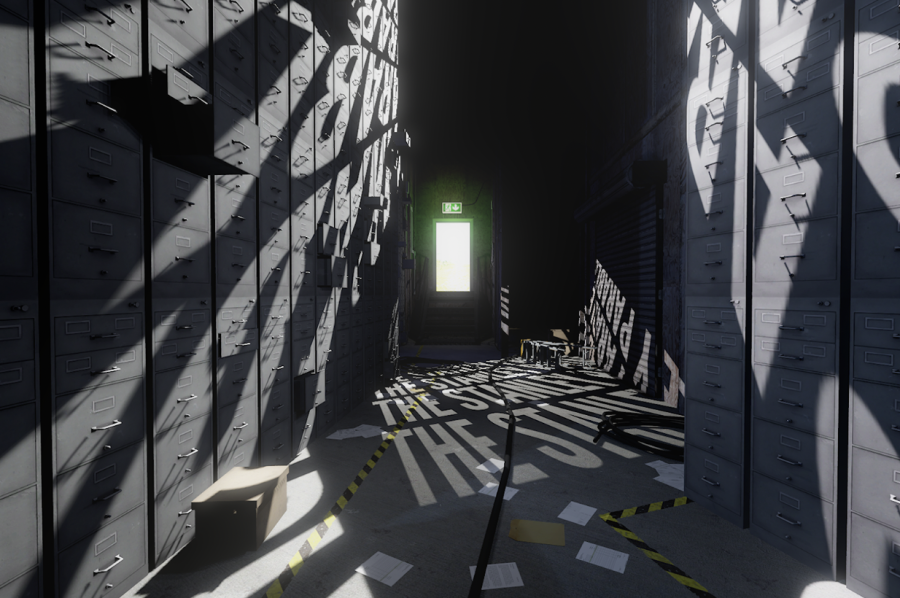Video Game Review: The Stanley Parable: Ultra Deluxe
Credit: Courtesy of Crows Crows Crows
After the release of “The Stanley Parable: Ultra Deluxe,” join sophomore Ari Zukerman on a review of a game eight years in the making.
June 4, 2022
Warning: Contains spoilers for The Stanley Parable: Ultra Deluxe
“The Stanley Parable” is one of my favorite video games due to the way it subverts expectations. When the long-awaited expansion of the game “The Stanley Parable: Ultra Deluxe,” was released on April 27, it met my hopes created by the original game by further defying my expectation.
For those who don’t know too much about the original game, the premise of the video game is quite simple: what if you disobey the developers’ wish? In most AAA or major games, you don’t have a choice in the plot of the video game. Instead the plot presented is a simple path to victory. However, in “The Stanley Parable,” the player, who acts as an employee of a big company named Stanley with the assigned number “427” and whose coworkers have all disappeared, is given a choice between listening to The Narrator to find out what happened to his fellow employees and eventually “win” the game, or forging their own path to explore an enthralling office park and discover new surprises while hearing The Narrator bash you for disobeying them, in a way that at first may seem unsettling. While the game’s plot is very shallow, it still plays into the game’s parodic take on the modern big story-driven games.
The game developers purposely hid the premise of the game from the public from the game’s announcement until its release day because the purpose of the game is to surprise the player. Additionally, if the developers wanted to keep an element of surprise, then a lot of the classic sequel ideas wouldn’t work. If the developers were to add predictable elements such as more endings, openable doors, changing the original plot or messing with the graphics, the aspect of unsettling surprise would disappear, removing the entertainment. The game’s writer, Davey Wreden, who became famous from both the original “The Stanley Parable” and the metafictional “The Beginners Guide,” continued his streak of ingenious creativity within the design of the sequel.
“The Stanley Parable: Ultra Deluxe” expands on the original in a way only Wreden could have come up with. Stanley’s office is identical to the 2013 release at the start, barring a few very small modifications that only super fans recognized. Then, after walking through a door labeled “NEW CONTENT,” which appears following a few playthroughs, the ability to jump is announced as the new feature added to “The Stanley Parable: Ultra Deluxe” by the creator of “Gravity Falls,” Alex Hirsch, and then sends you back into the office building. Next, the game’s trademark narrator (performed by arguably the best voice actor in any video game, Kevan Brighting) has a crisis of sorts. He explains how modern game developers abandoned the art of creating a good sequel and announces that he is taking on the challenge of making a good sequel by correcting the problems found by negative user reviews. Incomplete features such as an achievement generator that doesn’t work and a button that says your name, which is also incomplete and only says “Jim,” are displayed in an expo hall. The expo hall also includes a nondescript QR code that leads to a 10 minute long video that mocks sequels in classic Wreden style. That easter egg is one of my personal favorite parts of the game. The Narrator then comes to the conclusion that the game would be better off throwing the mostly incomplete content he boasted about into the original game, and at the next restart, the game is filled with new action, choices and unique quips.
The new content feels a bit more free and is more jest-heavy than the original content at first glance. For the best experience, “The Stanley Parable” is a game meant to be played without prior knowledge of the comedic aspects since the unsettlingly random side of the game is what makes it fun at first. Once the player has gone through enough playthroughs to unlock the new endings in the reimagining, they know about The Narrator’s impertinent side. Also, even though the player has played the game multiple times by that point, the transitions between the original content and the new sequel content can still be jarring in an entertaining way. For example, The Narrator transitions between telling Stanley that he is dealing with harsh hallucinations to getting them to decide between what’s a bucket or not in a way only The Stanley Parable would feature.
Speaking of buckets, the most random change shown off in the expo hall is probably the addition of an optional bucket, which The Narrator insists has comforting powers despite its out-of-place location in a game where you wander about an office park. Every original ending has been recreated with a new spin on the regular version if the player picks it off a pedestal before the first decision is presented to the player. While some of the changes are very noticeable, some of them are more minute details that many don’t notice. The game is very detail-oriented, relying on the player to find a small change or wait a long time for The Narrator to crack a joke. The bucket is a proponent of this, and it’s quite unnoticeable to those who don’t want to wait, but if you do, there is indeed a reward of discovering something new.
The game’s overhaul is not just limited to new content, however. The game was ported to the Unity game engine for a more modern toolset and better performance. Albeit in my experience, the game had many moments that resulted in performance that was far below optimal. However, despite the change in engine, the game somehow manages to keep the same look and feel. Even The Narrator’s voice still has the same blemishes, despite the game being mostly remade from scratch. These subtle consistencies show a wonderful display of technical artistry within the game.
Also included in the expansion is a soundtrack that matches the game in a parodic way, poking fun at some of the endings, especially the epilogue. The soundtrack is not something worth listening to on its own, but it’s still very enjoyable when mixed with the game. Especially when the game’s art director features as the vocals for an ending song that wasn’t originally supposed to be in the game.
The biggest downside of the game, in my opinion at least, is the price. For the length of the game, I’m not sure $25 is worth it for non super fans of the previous version. I still think it’s worth it for those who care about the series, as well as people who don’t know anything about Stanley, though. In my opinion, even with the 33% temporary discount, which lasted for two weeks from the release of the title, the game could’ve stayed as DLC (downloadable content) for the, at most, four new hours of content. The lack of new material is probably why it’s marketed as “The Stanley Parable: Ultra Deluxe” and not “The Stanley Parable 2.” However, selling a completely remade game as an expansion pack isn’t possible due to the amount of manpower needed to create the game. Crows Crows Crows is an indie studio selling a story-driven game with little room for in-game purchases, leaving the money-making to the upfront cost. If you are willing to pay the price Crows Crows Crows wants to sell “The Stanley Parable: Ultra Deluxe” for, you can have fun, but some may not find the value proposition reasonable.
Overall, in my opinion, the game deserves a nine out of 10. “The Stanley Parable” and its modern expansion can’t really be compared to anything since there’s nothing else in its class of games, with its unique mix of interactive storytelling and humor. Words can’t really do the format justice. To understand the game’s worth, you have to play it through and find the little quirks Davey Wreden is renowned for.





![Last Wednesday, the Wayland School Committee gathered to discuss a number of topics regarding the health curriculum and Innovation Career Pathway course. Another large topic of conversation was the ways to potentially mitigate distracting cell phone usage. "These [phones] are going to distract your learning and social relationships," Superintendent David Fleishman said. "That's concrete right there."](https://waylandstudentpress.com/wp-content/uploads/2025/06/Screenshot-2025-06-04-at-9.49.31 PM-1200x886.png)



























![Troy Hoyt finishes the Boston Marathon, running for the Hoyt Foundation. T. Hoyt is the son of Hoyt Foundation CEO Russ Hoyt.
“[Running a marathon] might seem like a big thing, when it’s presented to you at first, but if you break it up and just keep telling yourself, “Yes, you can,” you can start chipping away at it. And before you know it, you’ll be running the whole 26 miles, and you won’t even think twice about it.” T. Hoyt said.](https://waylandstudentpress.com/wp-content/uploads/2025/04/C36E8761-1CBB-452E-9DF2-543EF7B1095E_1_105_c.jpeg)













































